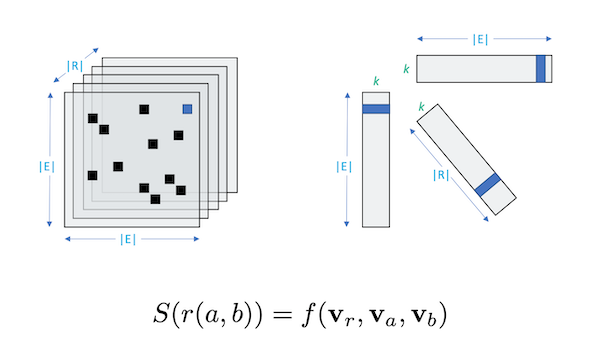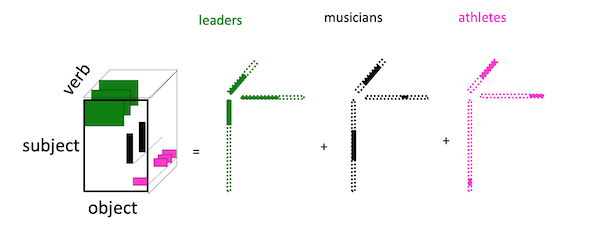知识图谱图嵌入
基础知识
数据的表示
Scalar: a 标量,0维
Vector: a[i], 向量,1维
Matrix: a[i,j], 矩阵,2维
Tensor: a[i,j,k], 张量,多维
Tensor和 Graph的关系:
Graphs over time -> 3rd order tensors
Knowledge Graphs: a directed heterogeneous multigraph whose node and relation types have domain-specific semantics (Vertices: Entities, Edges: Predicates)
有向、异源、对关系图
为什么要进行嵌入?
Meaningful non-numerical representations are highly important, e.g., languages with discrete representations, graphs, shapes
But, Most inference models, e.g., SVM, NN, Reg., etc., are designed for vector-space representable quantities
=>
To benefits from these models, we need to convert non-numeric representations to numeric representations
简单的说,就是将高维的离散信息转化为低维的连续数据,并且保持其信息的完整性,用于后续的建模分析。
嵌入
定义:
Mapping of a discrete variable to a vector of continuous numbers such that semantic/abstract similarities are encoded in terms of geometric distances
• Low-dimensional -> Mitigate redundancy, curse of dimensionality(避免维度灾难)
• Embeddings provide a generalizable context about the overall
graph that can be used for interference, e.g., relations.
图嵌入
Given entities & predicates, find mappings for entities and links (predicate (s,r,t))
就是将实体或者关系以向量的形式表达。
图嵌入方法
SVD
- Decomposition in terms of singular values
- V, U: orthogonal matrices
Deep Graph Embeddings
Skip-gram: DeepWalk, Node2Vec
思想:
Sample a set of paths with random walk from node 𝑣i
Adjacent Nodes are Similar and should have similar embeddings. The frequency of co-occurrence in random walks is an indicator of node similarity.
- Hierarchical Softmax (DeepWalk)
- Negative Sampling (Node2Vec)
其他算法
Metapath2Vec: heterogenous graph
LINE: 1st order + 2nd order proximity
UltimateWalk: closed form, unifies DeepWalk and Node2Vec reconstruct W,
AutoEncoder: similar to SVD
Struc2Vec: focuses on structural similarity
GCN: interesting! borrowed the idea from CNN
图嵌入应用
• Reconstruction / Fact checking: Triples completion: (s,?,t)
• Classification: Triples classification: (s,r,t)
• Featurizing: Link prediction, Recommendation
Tensor与图嵌入

PARAFAC
针对图张量的分解
知识图谱嵌入
Problem statement:
How to enforce KG structures on the embedding representations?
Solution: Triple scoring
Loss: what shall we optimize?
Triple Scoring
What is the relationship among sub (h), pred (r), and obj (t)? • Addition: h + r =?= t
表示实体关系向量间的关系。
- Addition: h + r =?= t
- Multiplication: h ⚬ r =?= t
Addition
查看 h + r 是否 = t
TransE算法:
score(h,r,t) = – ||h+r-t|| 返回结果二范式的负值
1 | |
缺陷:
从公式就可以看出,该算法不适用于一对多的关系
TransH:
Project to relation-specific hyperplanes
TransR:
Translate to relation-specific space
Multiplication
查看 h ⚬ r 是否 = t
RESCAL算法, score(h,r,t) = h.T ⚬ Wr ⚬ t
缺陷: Too many parameters
DistMult算法, score(h,r,t) = h.T ⚬ diag(Wr) ⚬ t
好处: Simplify RESCAL by using a diagonal matrix
缺陷: Cannot deal with asymmetric relations!
ComplEx算法: score(h,r,t) = Re(h.T ⚬ diag(Wr) ⚬ t)
Extend DistMult by introducing complex value embedding, so can handle asymmetric relations
Loss
Closed world assumption: square loss
本博客所有文章除特别声明外,均采用 CC BY-SA 4.0 协议 ,转载请注明出处!